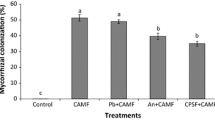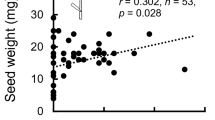Abstract
The objective was to study CO2 fixation and photoassimilate partition in coffee (Coffea arabica) seedlings infested with the lesion nematode Pratylenchus coffeae. Seedlings infested with 0, 1000 and 8000 Pratylenchus coffeae nematodes were exposed to 14CO2 and the incorporation and distribution of radioactivity were followed in the roots, stems and leaves. Fresh mass, pigments, soluble sugars, sucrose and specific radioactivity of sucrose in the plant parts were determined. At the highest level of infestation almost all the parameters were significantly changed showing the carbon fixation in the leaves and partitioning to the roots were decreased. Since lesion nematodes are not sedentary and do not form feeding sites that could be characterised as metabolic sinks, it is suggested that their damage is more readily expressed by the leaves, through a reduction in photosynthesis and phloem transport.
Similar content being viewed by others
References
Bird AF and Loveys BR (1975)The incorporation of photo-synthates by Meloidogyne javanica. Journal of Nematology 7:111-113.
Campos VP, Sivapalan P and Gnanapragasam NC (1990) Nematode parasites of coffee, cocoa and tea. In:Luc M, Sikora RA and Bridge J (eds)Plant Parasitic Nematodes in Subtropical and Tropical Agriculture (pp 387-430)CAB International, Wallingford, UK.
Carneiro RG, Mazzafera P and Ferraz LCCB (2000)Carbon partitioning in soybean infected with Meloidogyne incognita and M. javanica. Journal of Nematology 31:348-355.
Chaplin MF (1986)Monosaccharides. In:Chaplin, MF and Kennedy JF (eds)Carbohydrate Analysis:A Pratical Approach (pp 1-36)IRL Press, Oxford, Washington DC.
Davies E (1987)Plant Responses to wounding. In:Davies DD (ed)Physiology of Metabolism (pp 243-264)Academic Press, New York.
Dubois MK, Giller KA, Hamilton JK, Ribers PA and Smith T (1956)Colorimetric method for determination of sugars and related substances. Analytical Chemistry 28:360-365.
Duncan LW, Inserra RN, Thomas WK, Dunn D, Mustika I, Frisse LM, Mendes ML, Morris K and Kaplan DT (1999) Molecular and morphological analyses of isolates of Praty-lenchus coffeae and closely related species. Nematropica 29: 61-80.
Edwards DI and Wehunt EJ (1973)Hosts of Pratylenchus co. eae with additions from Central American banana-producing areas. Plant Disease Reporter 57:47-50.
Hussey RS (1985)Host-parasite relationships and associated physiological changes. In:Sasser JN and Carter CC (eds), An Advanced Treatise on Meloidogyne Vol. 1 (pp 143-153) North Caroline State University Graphics, Raleigh.
Inomoto MM, Oliveira CMG, Mazzafera P and Gonçalves W (1998)Effects of Pratylenchus brachyurus and P. coffeae on seedlingsof Coffeaarabica. JournalofNematology30:362-367.
Inserra RN, Duncan LW, Troccoli A, Dunn D, Maia dos Santos J, Kaplan D and Vovlas, N (2001)Pratylenchus jaehni sp. n. from citrus in Brazil and its relationship with P. coffeae and P. loosi (Nematoda:Pratylenchidae). Nematology 3:653-665.
Kubo RK, Silva RA, Tomazini MD, Oliveira CMG, Mazzafera P and Inomoto MM (2003)Patogenicidade de Pratylenchus coffeae em plântulas de cafeeiro cv. Mundo Novo. Fitopat-ologia Brasileira 28:41-48.
Lichtenthaler HK and Wellburn AR (1983)Determination of total carotenoids and chlorophylls a and b of leaf extracts in different solvents. Biochemical Society Transactions 11:591-592.
Monteiro AR and Lordello LGE (1974)Encontro do nemató-ide Pratylenchus coffeae atacando cafeeiro em São Paulo. Revista de Agricultura 49:164.
Poskuta JW, Dropkin VH and Nelson CJ (1986)Photosynthe-sis, photorespiration, and respiration of soybean after infection with root nematodes. Photosynthetica 20:405-410.
Riedel RM, Forter JG and Mai WF (1973)A simplified medium for monoxenic culture of Pratylenchus penetrans and Ditylenchus dipsaci. Journal of Nematology 5:71-72.
Silva RA and Inomoto MM(2002)Host-range characterization of two Pratylenchus coffeae from Brazil. Journal of Nema-tology 34:135-139.
Sturm A (1999)Invertases:primary structures, functions, and roles in plant development and sucrose partitioning. Plant Physiology 121:1-7.
Southey JF (1986)Laboratory Methods for Work with Plant and Soil Nematodes Her Majesty's Stationery Office. London.
Vaast Ph, Caswell-Chen EP and Zasoski RJ (1998)Effects of two endoparasitic nematodes (Pratylenchus coffeae and Meloydogyne konaensis)on ammonium and nitrate uptake by Arabica coffee (Coffea arabica L.). Applied Soil Ecology 10:171-178.
Van Handel E (1968)Direct microdetermination of sucrose. Analytical Biochemistry 22:280-283.
Author information
Authors and Affiliations
Rights and permissions
About this article
Cite this article
Mazzafera, P., Kubo, R.K. & Inomoto, M.M. Carbon Fixation and Partitioning in Coffee Seedlings Infested with Pratylenchuscoffeae . European Journal of Plant Pathology 110, 861–865 (2004). https://doi.org/10.1007/s10658-004-4839-4
Issue Date:
DOI: https://doi.org/10.1007/s10658-004-4839-4




